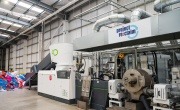Report identifies actions waste sector must take to achieve circularity
The National Infrastructure Commission has published a baseline report that identifies the key challenges facing the UK’s economic framework, with a section dedicated to the role of the waste sector in encouraging circularity.
Published ahead of the Second National Infrastructure Assessment, which is due for publication in 2023, the Commission will use the report to make recommendations that address the fiscal challenges faced by the Government.
 Within the chapter dedicated to the waste and resource management industry, the report states that circularity can be achieved through ‘increasing recycling rates of both municipal and construction waste’, as well as suggesting that net zero is to be reached through the identification of infrastructure ‘necessary to help the waste sector reduce its overall greenhouse gas (GHG) emissions.’
Within the chapter dedicated to the waste and resource management industry, the report states that circularity can be achieved through ‘increasing recycling rates of both municipal and construction waste’, as well as suggesting that net zero is to be reached through the identification of infrastructure ‘necessary to help the waste sector reduce its overall greenhouse gas (GHG) emissions.’
The findings of the report
In terms of its contribution to the country’s total GHG emissions, the waste sector accounted for approximately four per cent of the aggregate according to the study, sitting at 20MtCO2e. The report states that whilst there was a 40 per cent reduction in released carbon between 1990 and 2019, overall levels have been slowly increasing since 2015. Of this figure, landfill represented the majority of GHG emissions, whereas energy from waste (EfW) plants comprised 5MtCO2e, and incineration; anaerobic digestion (AD); mechanical biological treatment; and composting constituted 2MtCO2e of the total figure.
This general reduction is largely attributed to the introduction of the landfill tax in 1996, which saw the amount of biodegradable waste sent to such sites decrease by 84 per cent between 1990 and 2015, with methane emissions subsequently plummeting. Since the implementation of this legislation, however, there has been a 10 per cent increase in emissions from 2015, which the Commission ascribes to stagnating recycling rates and an uptake in incineration and EfW projects. The Commission states that a rise in burning waste will ‘make it difficult to achieve net zero emission targets without carbon capture and storage technologies’, though it does note that GHG output from energy recovery plants remain lower than those of landfill.
Whilst rates of recycling have stagnated in the past few years, the report does underscore the fact that, since 2000, there has been a general upward trend in collections, with 43 per cent of waste gathered by English local authorities in 2019 being recycled. Social surveys carried out as part of the report corroborated this trend, with public confidence in solid waste infrastructure and its capacity to meet the population’s needs over the next 30 years growing from 58 per cent in 2017 to 69 per cent in 2021.
The research also revealed that 70 per cent of respondents believed that businesses should be held responsible for the recycling and disposal of packaging waste, even if this would result in the price of products rising. Respondents to the survey also raised concerns surrounding overconsumption, excess packaging, and the transparency of waste disposal processes.
The next steps
In order to move towards a circular economy and meet national GHG reduction targets set by the Government – a 78 per cent reduction by 2035, relative to 1990 levels, with net zero to be achieved by 2050 – the report suggests some courses of action for the waste sector.
The Commission has recommended a municipal waste recycling target of 65 per cent by 2030 to be set in place – this should include a plastic packaging recycling target of 75 per cent, the body states. The report also urges the waste sector to incentivise recyclable packaging and product design, restrict hard-to-recycle plastics, and introduce a consistent collections standard for civic waste in order to prevent waste and keep products and materials in use for longer.
As for the issue of increased rates of incineration, the report prescribes the roll-out of carbon capture technology in order to reduce GHG emissions within EfW plants and biomass production sites. The Commission is prompting the Government to commit to deploying engineered carbon removal infrastructure at a megatonne scale by 2030, in which development has already commenced with proposed capture targets being increased from 10 MtCO2e a year by 2030, to 20-30 MtCO2e.
The Commission is also urging the Government to focus on increasing waste processing capacity, discontinuing the overseas export of waste, and expanding the sector’s interdependencies with other economic infrastructure sectors including energy and water, and construction waste.
Beyond proposed legislation, a call for evidence process has been launched by the Commission, which will see stakeholders submit data in order to inform work on the topics the report has identified. The Commission will also undertake sector events, regional visits and social research as it develops its recommendations.
Additionally, the formal objectives of the Commission have been expanded by the Chancellor to include explicit goals that bolster the transition to Net Zero and improve climate resilience. To facilitate this, the upper end of the ‘fiscal remit’ within which the body composes its recommendations has been increased from 1.2 per cent to 1.3 per cent of the annual GDP, which will potentially represent ‘billions of pounds in additional investment in infrastructure over the long term.’
Sir John Armitt, Chair of the Commission, commented on the three strategic themes identified by the Commission: “Each pose urgent and wide ranging questions. Each draws broad political and public support for their end goal. Each, however, offers few quick wins or cheap fixes.”
He added: “We will now embark on this work – informed by input and insight from industry, political leaders, representative bodies, other organisations across the country and the public – and formulate policy recommendations to put forward to the government.”




